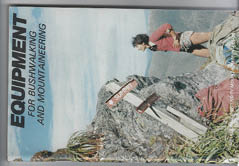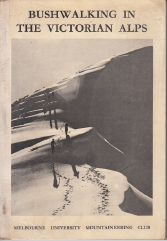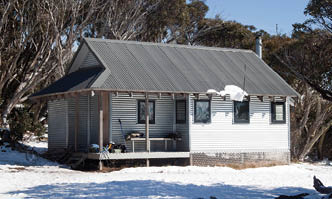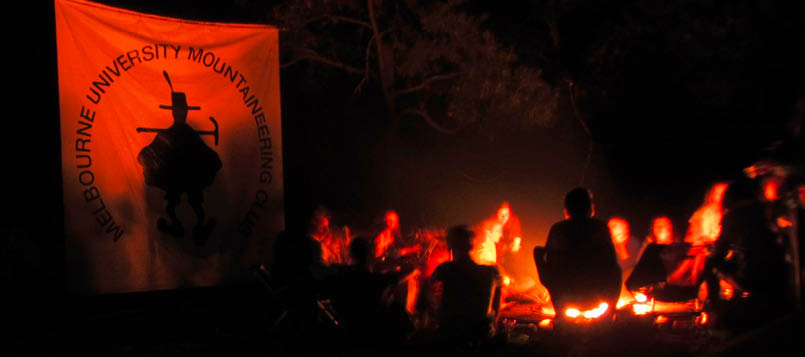


Melbourne University Mountaineering Club (MUMC) was founded in October 1944, and is celebrating 75 years. The following describes some of the history of MUMC.
Navigator, grade 21, GrampiansTaner Kucukyuruk

MUMC – 75 Years Old

52 | BWA October 2019

MUMC – A brief historyDavid Hogg
FormationThe Melbourne University Mountaineering Club began its life at a meeting held on 9 October 1944 when World War II was still in progress. It was founded largely through the efforts of Niall Brennan, who was elected to the position of Secretary at the Club’s first Annual General Meeting on 11 May 1945. Professor Thomas Cherry was elected as President and a formal Constitution was adopted.
With Australia recovering from the impacts of the war, the first couple of years of the club’s life saw only a modest level of activity, but this changed in 1947 when Bill Bewsher joined the club. Due largely to the efforts of Professor Cherry and Bill Bewsher, in the next few years the Club was responsible for the introduction of organised rockclimbing to Victoria and played a key role, along with the Hobart Walking Club and the Geelong College Exploration Society, in opening up the Federation Peak area of Southwest Tasmania to bushwalking. It also initiated its annual 24 Hour Walk, and assumed an active role in the Federation of Victorian Walking
Clubs (now VicWalk), particularly in relation to establishing the Federation’s search and rescue function at a time when the Victorian police force was limited in such expertise.
The 1950s and 1960sDuring the mid-1950s, the level of adventurous activities declined, due in part to the introduction of compulsory National Service which occupied many club members during the summer vacation. That period nevertheless saw the first visits by club members to New Zealand for serious mountaineering, but also its first mountaineering tragedy when John Young, John Vidulich and John Hammond (a non-member) died while attempting a traverse of Mount Cook. One of the club's early New Zealand mountaineers, Faye Kerr, went on to become one of the world’s most accomplished female mountaineers until her untimely death due to illness in India in 1980.
I joined MUMC in 1962, shortly before the club entered one of the most dynamic periods in its history. The Club had just acquired its first clubrooms, "Aikman’s Road", a dingy basement beneath 21 Royal Parade, which became its centre of action for most of the 1960s and 1970s.
Climbing in KyrgyzstanRichard Bassett-Smith
BWA October 2019 | 53
The early 1960s saw a new crop of enthusiastic members join the club and embark on a number of ambitious projects to the benefit of both the club and the wider bushwalking and mountaineering community.
At that time the main social event of the year was the annual club dinner, a formal affair with toasts to the Queen, the club and absent friends, which carried over from the early days of the club. As the decade progressed, interest in the dinner declined and it was replaced by a dinner dance, held at a lively venue in the Dandenongs.
Another great tradition of the club which prevailed throughout the sixties was singing on club trips, either to break the monotony of a long van ride or around a large campfire in the days when firewood around campsites was plentiful and there were no regulations on its use. The most popular song was La bella polenta, a lively Italian folksong with accompanying actions.
By the start of the sixties, the annual 24 Hour Walk had become very competitive and there were many who awaited the next event with great enthusiasm. It was a natural progression for the club to take the leading role in establishing an intervarsity version of the event, and for the competitive urges of some members to be further satisfied when orienteering was first becoming established in Victoria, a process in which some club members played a significant role.
An exceptional characteristic of the club during the sixties was its enthusiasm for undertaking ambitious projects, including the publication of Equipment for Mountaineering
and the Guide to the Victorian Alps, both of which became best-sellers within the wider bushwalking community.
The most significant project of the 1960s was the building of MUMC hut on Mount Feathertop, conceived as a memorial to club members Doug Hatt and Russell Judge, who died on Mount Cook in January 1965. The hut was designed by Peter Kneen and its building involved a major effort by many club members who carried materials several kilometres to the site. The hut captured the imagination of a large proportion of the club's members and was truly an exciting project with which to be associated. Club bushwalking almost ceased while the hut was being built but was replaced by an experience which many participants long remembered and valued.
During the 1960s, the club expanded its activities from bushwalking, rockclimbing and the occasional caving trip to include alpine climbing, ski touring and canoeing. It extended the 24 Hour Walk concept to become an intervarsity "orienteering" competition (akin to contemporary rogaining) and several of its members were instrumental in the establishment of traditional orienteering in Victoria and Australia.
ConservationConservation issues began to attract the interest of club members, particularly the proposed flooding of Lake Pedder which was a popular destination for club members in summer. During the late 1960s and the 1970s, several club members became active in the affairs of the FVWC, holding office bearer or convenor positions and playing

MUMC HutLuke Frisken

MUMC publications, 1974 and 1982

54 | BWA October 2019
Federation Hut on Mount FeathertopJimmy Harris

key roles in establishing the Federation’s newsletter, managing the Federation’s Mount Feathertop hut project (Federation Hut), and organising a public rally in support of an alpine national park. It continued to play a major role in the Federation’s search and rescue activities.
During the 1960s, bushwalking was by far the dominant activity in the club, and an organised series of regular day or weekend walks was conducted, particularly during first and second terms when the pressure of end-of-year exams was not evident. Most of these trips were large, typically involving about 30 people, with transport by picnic van, which would pull up outside the front of the Union Building.
The other main club activity of the time was rockclimbing but, apart from the annual climbing course, most climbing trips were small, attracting the hard-core climbers and a few others committed to improving their climbing skills. Continuing the tradition of the earlier decades, climbing in the early sixties was focused particularly on the Cathedral Range, the Grampians and Hanging Rock, but in 1964 this changed when Mount Arapiles suddenly became Victoria’s main climbing focus. Caving was a minor activity and, as the 1960s progressed, the club became involved in snow trips (including a basic alpine climbing course on Mount Feathertop), ski touring, canoeing and orienteering. In the summer vacation, the most popular destination was Tasmania, particularly the Cradle Mountain Reserve and the Southwest, where Lake Pedder prior to its flooding and Federation Peak were the main attractions.
The proposed flooding of Lake Pedder awakened the conservation interests of many club members, several of whom became involved with the newly formed Australian Conservation Foundation, whose headquarters were located a short distance up Royal Parade.
In summary, during the 1960s the club offered an enormous range of activities, projects and opportunities for external interaction. Most of its active members participated in a wide range of these. There were always new challenges emerging which attracted members to stay involved with the club and to contribute to it after their university days were over.
The 1970sFrom the 1970s onwards, community interest in outdoor recreation began to increase rapidly, as did the number of clubs catering for this interest and the number of commercial organisations servicing the outdoor recreation market. Publications
Gondoliers on the Thompson RiverCaitlyn Conway

BWA October 2019 | 55

which served the wider community were now being produced commercially and there was a declining role for the club in this area. Places such as Southwest Tasmania, which the club was instrumental in opening up, were now attracting many walkers, and no longer held the same aura of exploration. With long-distance travel becoming cheaper and easier, however, other opportunities in Australia and overseas were offering club members new sorts of adventures.
Most of the established activities in the club continued during its later decades, with occasional new ones added, such as canoe polo, canyoning and proactive conservation activities such as tree planting and threatened species surveys. Having provided the impetus for the establishment of rogaining by others during the 1970s, the annual 24 Hour Walk diminished in importance and was gone from the club's program by 1989. Throughout its later decades, the club remained one of the largest at the university and, despite peaks and troughs in some of its activities, continued to remain vibrant overall.
MUMC after universityFor many of its members, MUMC has been much more than a recreational club that just provided a break from the routine of academic study. For some, the experiences through the club have been a major factor in supporting or even changing the direction of their future careers. Such experiences have also resulted in some members playing key roles in other related community organisations later in life. The friendships
that began in the club frequently developed into family relationships or otherwise into lasting associations built largely around ongoing outdoor activities. The days of the club loom large in the memories of many of its former members and are kept alive by the reunion dinners which are conducted to mark the significant anniversaries of the club's founding.
.jpg)
The first of many first descents in the Marañón River, Muro Poso Canyon (lower), Peru Isabel Clare Cornes
Fireside at the 2017 annual MUMC Intro TripGina Snelling
56 | BWA October 2019

On the Origin of Species: OxoDale Thistlethwaite
This is an edited version of an article that appeared in the October 2014 edition of The Mountaineer, the magazine of MUMC.
All good scientists need research assistants, and I am no exception. My research for this study relied on the vast network of internet enabled oxos to answer one of the more vexing questions facing our species who named it? By tradition, the right to name a
new species is given to the first scientific describer of the species. Is there lurking out there in history a Bob or Barbara Oxo? As it turns out - no.
I consulted older oxos and found some assumed that the name came from the stock cubes, deducing that early MUMC members had backcountry cooking tastes that leaned invariably towards beef. However, I could find no scientific precedent for naming a species after its primary food source and so this line of reasoning was quickly, and thankfully, discarded.
Approaching the summit of BogongSonia Khiatani

Oxo man
BWA October 2019 | 57
Oxo Don Fell noted that he and his companions had used Oxo as a greeting when encountering other like-minded parties in the bush or mountains, and also for testing echoes, distinguishing themselves from the far calls of unrefined walking clubs. Other oxos concurred that they had used Oxo as a call, raising the romantic possibility that our species was named after its song like the Kea or the More-pork.
But oxo Tony Kerr cited an early recollection of the use of oxo going back to a trip to Matlock, led by Professor Cherry. Members of the trip had been using the response "Ox!" as a frequent retort to certain comments and claims made by other members this puzzled the Professor for a while. Eventually he turned to one of the party members and asked: What does this Ox mean? "Well Prof, you know that an ox is like a bull? To which the professor replied "Oh, I see &"
So it seems we must conclude that oxos are likely to have been named after their bullshit detector and from ox to oxo, from a retort, to a slang word, to a call sign the exact circumstances of these transitions are not known. But somewhere along the way, from its use as a bush call, to its first recorded association in the sixties with the Tyrolean mountaineer silhouette who would be-come oxoman, oxo became our name.
Reflections on MUMC of the 1960s and 1970sBy Michael Feller
MUMC was above all an integral part of the all-round education a university was supposed to provide. MUMC greatly enriched one's social, intellectual, and even spiritual development. It allowed one to develop self-esteem and important life skills, particularly those related to physical fitness, wilderness survival, social survival, and spatial navigation. It even provided many people with life partners and careers. Why?
MUMC members were very friendly and accommodating. Within three years, this rather shy person had found a place at Melbourne Uni that he could call home and on whose committee he could serve. The club rooms were in a rather dingy basement of a house across from Melbourne Uni in Royal Parade - Aikmans Road. Dingy, but warm and friendly. Trips to impressive bush destinations, mostly wilderness, became the weekend norm. Transport for these trips was by furniture van, fitted with rows of seats that faced one another, allowing much conversation, much camaraderie, much singing, and much meeting of people. Many couples formed and MUMC became known in time as the Melbourne Uni Matrimonial Club. Building of the Feathertop hut and the NW Spur walking track took up a year of my life and became another great friend-building, physical fitness-developing (some of us tried to see who could carry the heaviest load up - loads of 50 kilograms were not uncommon), and socialising experience. Mount Feathertop became my shrine. Covering over 160 kilometres in a 24 hour walk was an additional highlight. All these experiences complemented the intellectual education experiences of the university. Today's university web-based degrees provide nothing remotely comparable and such a university “experience” is hugely impoverished by comparison.
After five years of post-graduate work in Canada, I returned to Melbourne Uni as a lecturer in the mid-seventies. Naturally, I became active again in MUMC. By then van trips had been replaced with private car trips, but the basic physical, social, aesthetic and

Crossing the Beansburn River, the Five Passes hike, NZDanielle Andreasen-Cocker
58 | BWA October 2019
.png)
educational experience that MUMC provided remained intact and MUMC continued its function as a Melbourne Uni Matrimonial Club. A highlight of this period was the running of ski trips rather than the desperate snow walks of the sixties. Skiing was greatly preferable to wading through deep snow (perhaps another disappearing feature of the Victorian environment), accompanied by camping using marginal equipment – a groundsheet or lilo directly on the snow with a flimsy cool sleeping bag, having to get up at night and go for a walk to warm up.
Another highlight of this period was the exploration of wilderness gorges throughout Eastern Victoria – Little River, Snowy River, Bryces, Jamieson River, Genoa River, etc. This, together with the expansion of logging and fire access road construction throughout the remaining bush, the formation of the
Land Conservation Council and the push for the creation of an alpine national park, raised an awareness of the need to protect our remaining wilderness and opportunities for our forms of wilderness recreation. MUMC was at the forefront of bushwalker’s wilderness conservation activities, I became the club's first conservation chair and, in 1979, it was mainly MUMC members who produced the first wilderness inventory for Victoria.
It is said that one's life expectancy is enhanced by having a strong group of friends. A large group of 1960s MUMC members continues to regularly meet today and enjoy mountaineering experiences together, even with replaced hips and knees! What more could one ask of a university club?
Rafting and canyoning, Marañón River, Peru, to help conserve one of the last undammed rivers in South AmericaAnja Fuechtbauer
BWA October 2019 | 59


MUMC 75 years on Alex Hormann, current MUMC Secretary
Seventy-five years since inception, MUMC is still holding strong and seems incapable of being knocked down, though that’s not to say there haven’t been attempts. Those well acquainted with the club know of the fateful incident back in 2015 that led to a university ban on all of our rope sports (climbing, caving, canyoning and mountaineering), leaving a significant dint in what kinds of trips we were able to run. But with over 70 years of experience, we were not a club that would be knocked down easily.
Since then we have been on a determined path to prove we deserve the sports back, through even further improved safety measures and consultations with safety experts. We are glad to say that we have our much loved sport of rock-climbing back and we are focussing on re-establishing the sport and training a new generation of climbing leaders. The future is looking bright.
Controversy aside, our club seems to still continuously pull in hundreds of members annually thanks to our active sports of paddling and bushwalking, alongside new weekly nights of “Monday indoor climbing” and “Thursday board games”. Every new member is amazed at our relatively new (as of 2013) clubrooms, which, when I first saw it two years ago, I could only describe it as an “outdoor sports Mecca”. MUMC Hut got solar panels earlier this year, our archives are now nearly entirely digitised and our library is continuously expanding! Our annual midnight ascent trip to the club hut is still running, this year with the addition of one makeshift inflatable pool spa thanks to some nifty organisers and keen pack mules. Our new 75th anniversary edition of The Mountaineer is coming soon and our annual “Pie and Slide” competition night is sure to attract a new batch of amazing photographs.
Even with the drama of the rope sports bans, keen senior members are still pushing the boundaries of what is possible within the sports. One only has to look at our past “Adventure Grant” winner’s trip: where they kayaked across from Wilsons Promontory to northern Tasmania, setting up new climbing routes along the way in the Kent Island Group; to see that climbing within the club is far from dead. The thing about being knocked down is that there is only one direction to travel: back up. And if there is one thing the mountaineering club is good at, it’s climbing up things! The current future goals of the club is to regain and rebuild our rope sports and to further correspond with and build relationships with intervarsity outdoors clubs.
The current access and conservation issue of climbing bans within Grampians National Park is also at the forefront of our minds as we continue to provide a leading voice in discussions on how to approach the topic. The club is looking good, both literally in our shiny new clubrooms and figuratively. We’re looking forward to another great 75 years!
As for me? When I first joined the club two years ago, to somebody who had little experience in the outdoors it looked almost too good to be real. It provided me with experiences I thought I could never achieve in university. I have tried and enjoyed nearly every sport the club has to offer (except for mountaineering, but soon that will be ticked off the list as well) and gained amazing friends, amazing memories and skills in outdoor survival and leadership. Though the club has, and will always have, a large proportion of members who are “superficial”; for a number of us the club means much more than just a means for outdoor adventure. I consider the clubrooms my second home and MUMC my second family and I look forward to seeing through the future of the club.
Sunrise at MUMC Hut after the 2018 midnight ascentSteven Birkett
60 | BWA October 2019